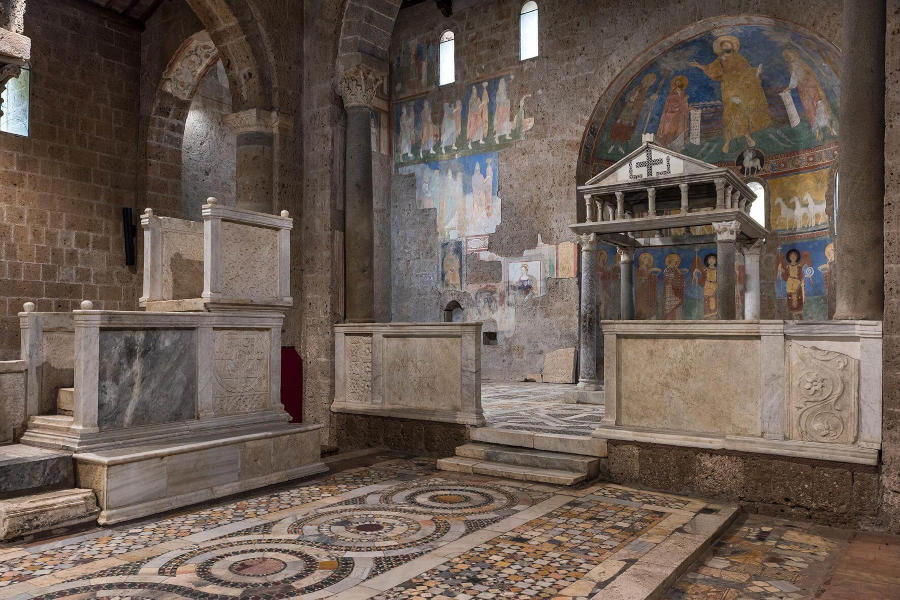Nepeasy is your go-to portal for discovering Nepi and its enchanting surroundings. Located in the heart of Tuscia Viterbese, Nepi is an ideal starting point to explore the hidden treasures and breathtaking landscapes that define this region rich in history, culture, and traditions. Whether you’re seeking unique adventures or a tranquil journey back in time, join us as we uncover two nearby villages: Castel Sant’Elia and Sutri. These destinations offer a perfect blend of natural beauty, art, and history, promising unforgettable experiences just a stone’s throw from Nepi.
Castel Sant’Elia: A Charming Step Back in Time
Just 3 kilometers from Nepi, nestled among tuff gorges and verdant expanses, lies the village of Castel Sant’Elia. This historic spot provides a unique immersion into an ancient atmosphere, perfect for those who seek beauty where nature meets spirituality. The village’s origins date back to the Etruscans, with visible Roman and medieval influences in its old fortifications and cobblestone streets. Here’s what to see:
The Basilica of Sant’Elia, dating back to the 8th century, is the historical and spiritual heart of the village. Known for its imposing central portal, the basilica is adorned with motifs symbolizing the eternal struggle between good and evil, represented by intricately carved animal and plant figures.
Inside, the basilica offers a serene space for meditation and reflection, with its three naves and dimly lit transept creating a sense of tranquility and retreat. The frescoes decorating the apse and side walls, depicting Christ the Redeemer and scenes from the Apocalypse of St. John, are striking examples of religious art that invite contemplation.
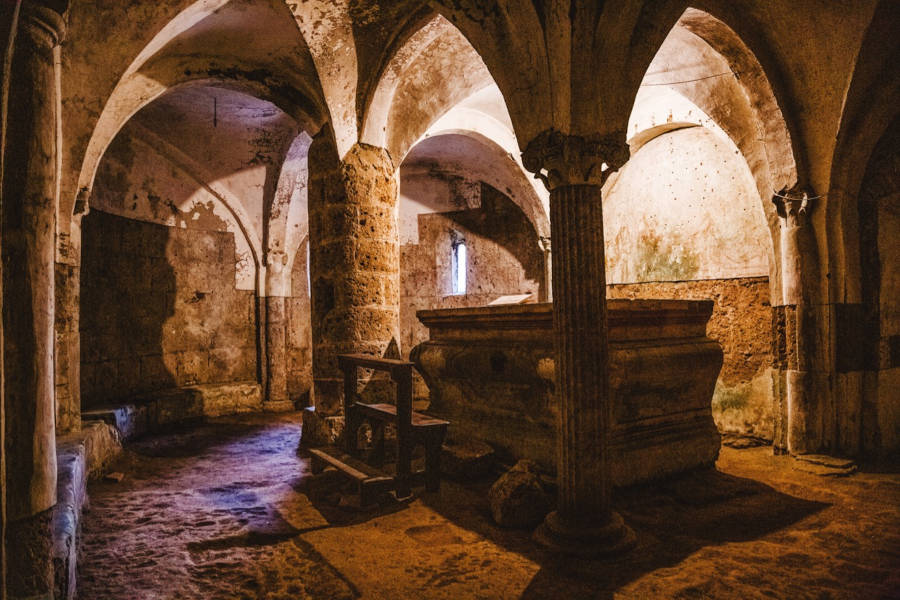
Another unmissable place of faith is the Pontifical Sanctuary of Maria SS.ma Ad Rupes. Perched on the edge of the Valle Suppentonia, the Sanctuary stands as a silent witness to centuries of Marian devotion, dating back to its original settlement by Benedictine monks in 520 AD.
The veneration of the Madonna at this site has endured through the centuries, surviving even five centuries of abandonment following the departure of the Benedictines in 1258. However, the arrival of Fra’ Giuseppe Andrea Rodio in 1777 marked the beginning of a renewed era of splendor for the Sanctuary. He undertook the creation of a monumental staircase of 144 steps carved directly into the tuff, an impressive feat that made access to the Grotto more accessible for pilgrims.
In 1892, the Franciscan Friars took over the custody of the Sanctuary, continuing work that gave the structure the appearance we admire today. Its designation as a Minor Basilica and the conferral of the title of Pontifical in 1912 further elevated its spiritual and architectural significance.
The Grotta of the Madonna, the central element of worship, dates back to the 6th century and houses a Marian image from the 16th century, which replaced an earlier fresco. The iconography of this Madonna “ad Rupes” is particularly unique as it depicts the Virgin adoring the sleeping Child, a rare theme in Christian artistic tradition.
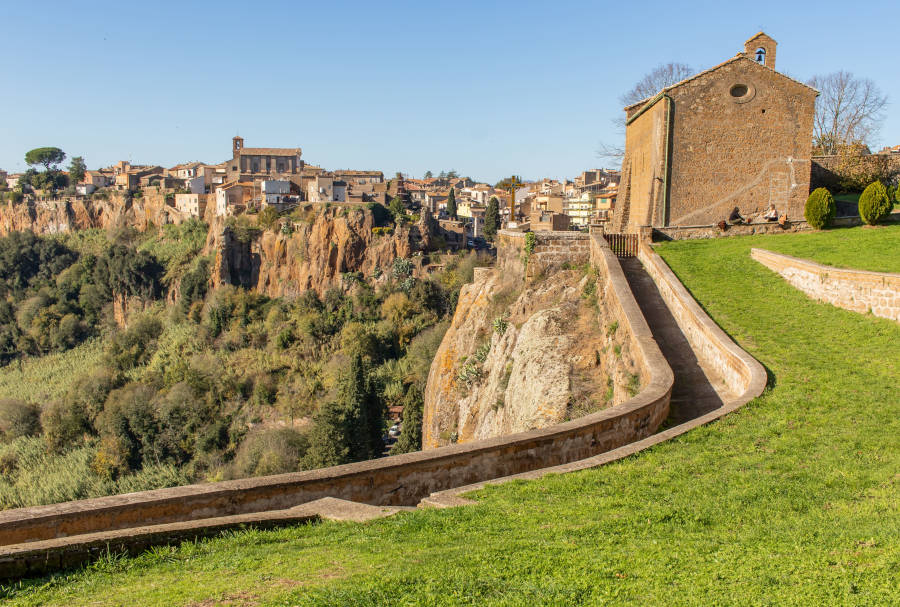
Between 1908 and 1910, to accommodate the growing number of pilgrims, the Basilica of St. Joseph was built. It features a Gothic style and a bell tower with chimes tuned to the same notes as those of St. Peter’s Basilica in Rome. The interior of the basilica is adorned with artworks such as the Way of the Cross, the Lectern, and a Triptych in the apse that includes a replica of the Crucifix of San Damiano.
Today, the Sanctuary remains a significant landmark for the faithful, cared for by the Congregation of St. Michael the Archangel, and continues to be a place of great natural beauty and spiritual tranquility, attracting visitors seeking peace and reflection.
In addition to the basilica and sanctuary, the Civic Museum of Castel Sant’Elia is worth a visit for its exceptional collection of sacred vestments, documented since the 19th century. These items, first exhibited in 1896, testify to the care and preservation of religious heritage over the centuries. The museum highlights the collaboration between civil and religious authorities in the management and safeguarding of these treasures.
For nature enthusiasts, the Hermit Trails offer a unique opportunity to explore the distinctive ecosystem of the Agro Falisco. Characterized by extensive tuff formations and deep valleys, the area hosts a biodiversity that shifts with the seasons, providing ever-changing and captivating landscapes.
Sutri: a masterpiece of history and culture
Approximately ten kilometers away, Sutri welcomes visitors with its impressive archaeological heritage. The Archaeological Park, with its Etrusco-Roman necropolis and amphitheater, offers an extraordinary window into the past. The Mithraeum, an ancient place of worship, and Sutri’s Cathedral, featuring both Romanesque and Gothic elements, complete the cultural offerings of this historic village.
The Archaeological Park of Sutri holds immense historical and cultural value, making it a must-see for those visiting the region. According to legend, Sutri was founded by the god Saturn, from whom the village takes its name. Spanning seven hectares, Sutri boasts a rich heritage. Among its main attractions is the Roman amphitheater, entirely carved into the tuff rock without the use of supporting structures. Dating back to between the 1st century BCE and the 1st century CE, this amphitheater could accommodate around 7,000 spectators, showcasing the historical significance and engineering prowess of the time.
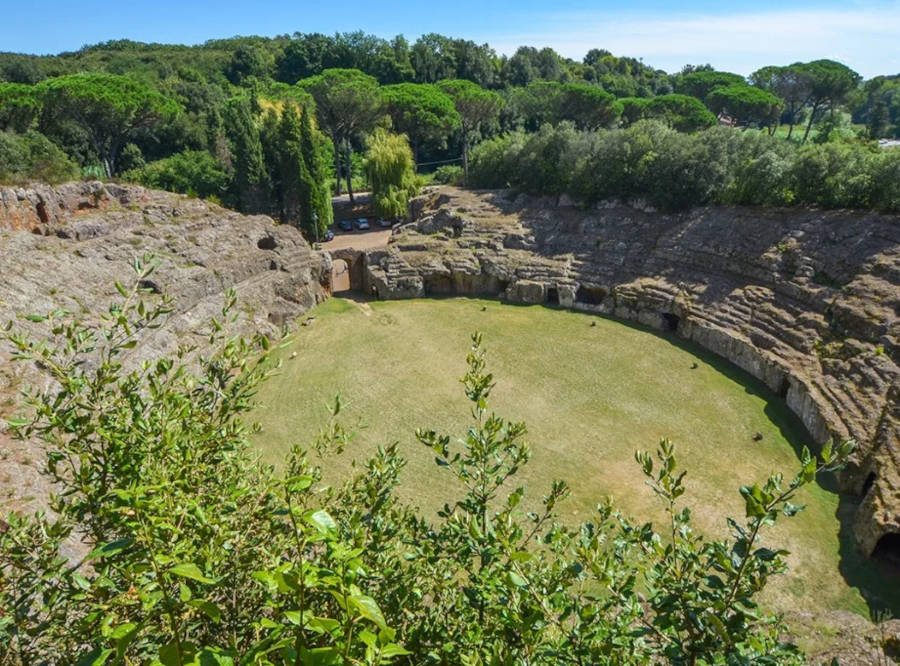
Beyond the amphitheater, the park includes an extensive rock-cut necropolis, with 64 tombs carved into the tuff. These tombs illustrate the evolution of Roman funerary practices, from inhumation to cremation, and were used from the 1st century BCE to the 3rd-4th century CE. They provide a unique glimpse into ancient burial practices and beliefs.
Another gem of the park is the Mithraeum of Sutri, a rock-carved structure that originally served as a place of worship for the god Mithras. Later converted into a Christian worship site, the Mithraeum preserves frescoes from different periods, including a notable depiction of the Nativity. Currently under restoration, the building reflects the continuity and adaptation of religious practices over time.
Overlooking the park stands Villa Savorelli, a magnificent example of Italian architecture and garden design from the Renaissance to the Romantic era. The villa offers breathtaking views of the Sutri area, and its Italian-style garden is a perfect spot for a relaxing stroll after exploring the archaeological treasures of the park.
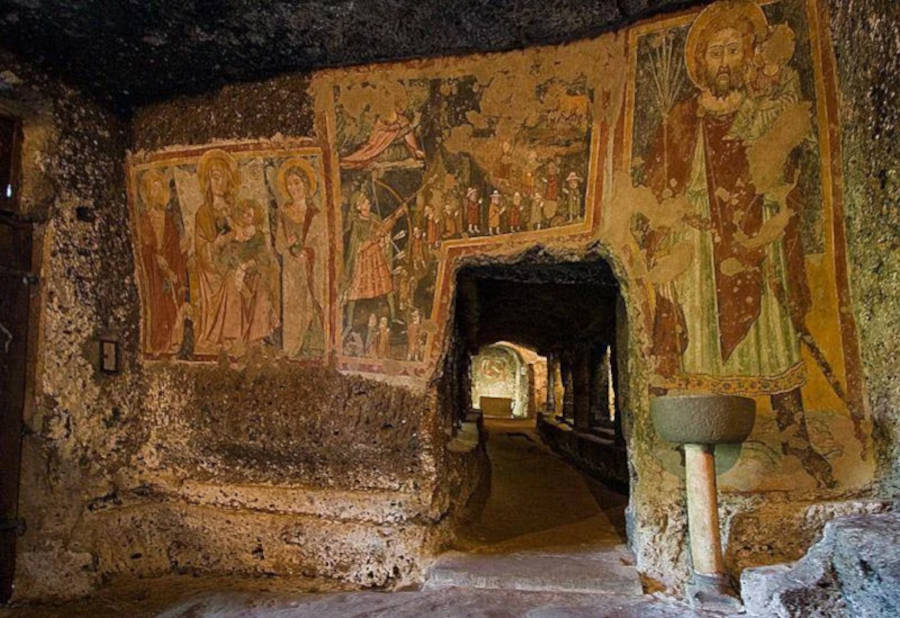
Visiting the Archaeological Park of Sutri is like diving into a fascinating chapter of history, uncovering the deep roots and traditions that have shaped this beautiful Italian region. Sutri is also culturally vibrant, hosting regular events and exhibitions at the Museum of Palazzo Doebbing, further enriching visitors’ experiences.
Local Gastronomy
After a day of exploration, there’s nothing better than sitting down at one of Sutri’s many restaurants to enjoy traditional dishes prepared with fresh, local ingredients, in the warm atmosphere that only authentic Italian villages can offer. For festival enthusiasts, the Sagra del Fagiolo di Sutri (Sutri Bean Festival), held annually in early September, has reached its 49th edition.
For those staying in Nepi and wishing to explore its surroundings, the destinations highlighted on this page are ideal for expanding your Tuscia visit. These places are rich in history, culture, and natural beauty, perfect for enhancing your stay with new discoveries and unforgettable adventures. Every corner of these villages has something to tell and offer, making them must-visit destinations for anyone exploring this marvelous region.
